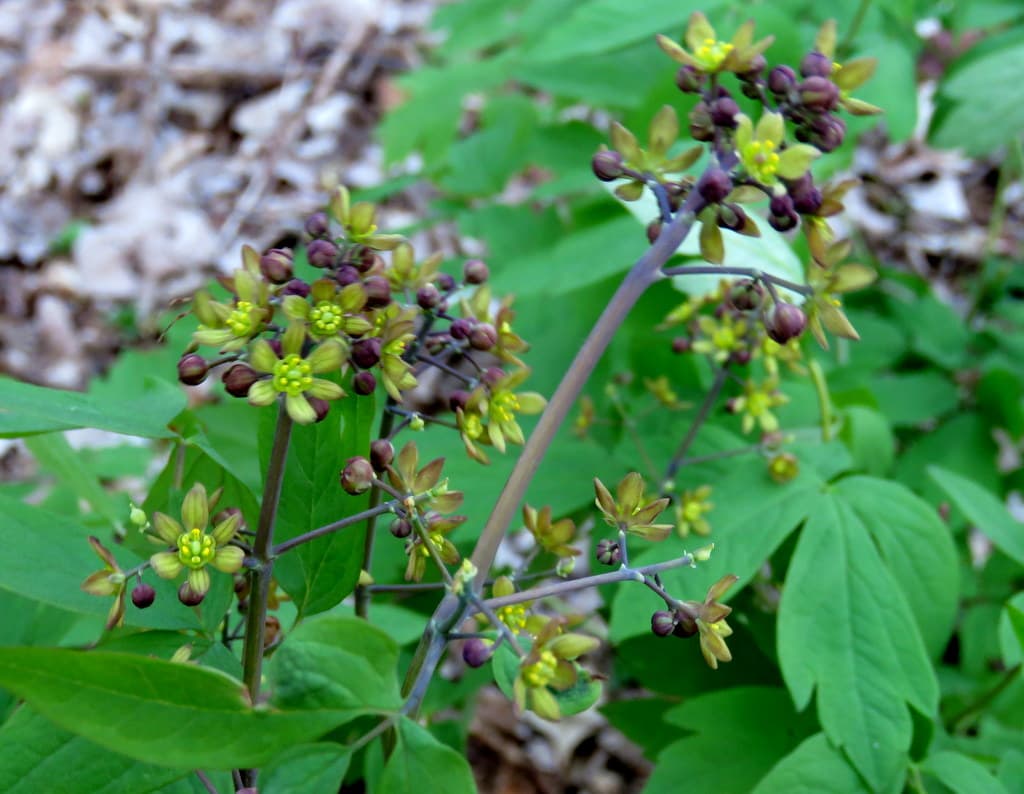
Scientific Name
Caulophyllum thalictroides
Common Names
Blue Cohosh, Papoose Root, Squaw Root
Plant Family
Berberidaceae
Location
Native to the rich, shaded woodlands of Eastern North America. Found from the Great Lakes to the Appalachian Mountains, often growing alongside trillium and goldenseal. Prefers moist, humus-rich forest soil and dappled light. Slow-growing and increasingly rare — best to use cultivated sources only.
Description
A perennial woodland herb with smooth, bluish-green, compound leaves and clusters of small yellow-green flowers in early spring. Produces bluish berries later in the season, though the berries are not used medicinally. The root is thick, knotted, and yellowish-brown when dried. The whole plant has a ghostly, ancient feel to it — strong but reserved.
Uses
Traditionally used as a uterine tonic, menstrual regulator, and childbirth aid. Stimulates uterine contractions and has been used by midwives (with care) to prepare the uterus for labor. Also used to bring on delayed or absent menstruation. Energetically, it helps move stagnation in the reproductive system, especially when there's cold or tension. Also, mildly antispasmodic and anti-inflammatory — sometimes used for rheumatism.
Energetics
Warming, stimulating, moving, grounding. Moves blood and Qi, breaks through deep stagnation, especially in the pelvic region. Has a subtle bitterness and grounding weight to it.
Parts Used
Root and rhizome (dried)
Constituents
Alkaloids (caulophylline), saponins (caulosaponin), resins, starches. The combination of saponins and alkaloids gives it both stimulating and relaxing actions.
Dosage
- Use cautiously and under guidance
- Tincture (1:5, 40% alcohol): 5–15 drops, up to 2x/day
- Decoction (rare): ¼–½ tsp per cup, simmered 20 min — very strong, seldom used as tea
Notes on Use
Blue Cohosh is not a gentle plant. Use it
when it's clearly called for — such as restoring menstrual cycles that have stopped due to cold or trauma, or supporting uterine tone in the weeks
leading up to labor (never alone, and always with care). It is a “deep mover” — not for people who are depleted or very sensitive.
It has a slightly toxic edge if overused, so keep it for specific moments and always combine it with gentler allies like raspberry leaf, motherwort, or vitex.
Harvesting
• Root: Harvest in late fall from mature plants. Dry well before storage. Use only cultivated root — wild populations are shrinking.
Contraindications
Not for pregnancy unless used by a trained herbalist or midwife at term. Do not use during early pregnancy or in miscarriage risk. Avoid in people with high blood pressure or those on cardiac medications. Overdose can cause nausea, vomiting, and uterine distress.
Recipes
- Birth Prep Blend (near term only): Blue cohosh, raspberry leaf, partridgeberry, ginger (small doses, short term)
- Cycle Restoration Formula: Blue cohosh, vitex, black haw, warming bitters
- Pelvic Tension Tincture: Blue cohosh, cramp bark, ginger